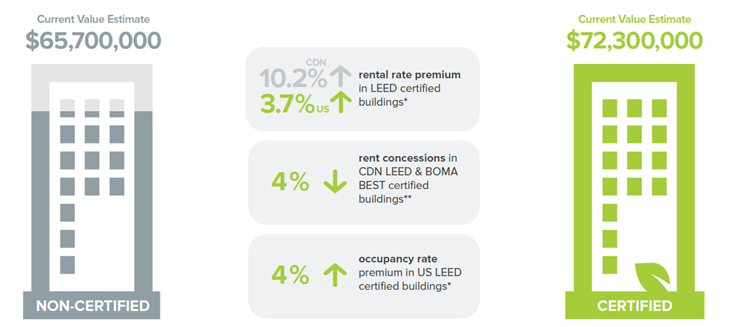Why Investments in Sustainability Pay Off in the Long Run
Bentall Kennedy and the University of Guelph reveal why, according to their study, green buildings are a win-win, providing financial benefits and making tenants happier and more loyal.
By Alexandra Pacurar
The discussion on the financial benefits of having green-certified buildings is not new. Neither is the debate as to the urgency to protect the environment. However, a unique study based on compelling data from investment advisory firm Bentall Kennedy reveals surprising reasons why developing sustainable properties is a good investment—including more long-term and happier tenants.
The study, interpreted by Dr. Nils Kok, associate professor of finance and real estate at Maastricht University in the Netherlands, and Dr. Avis Devine, assistant professor in real estate and housing at Guelph University in Canada, was based on data collected between 2004 and 2013 from the commercial real estate properties in Canada and the U.S. Specifically, it examined almost 300 office buildings, or 56 million square feet of commercial space, divided almost equally between the two countries.
Dealing with a large amount of data was a challenge for the researchers, as was the limited data on the topic. “The new trend of working with big data offers great opportunity for insight, but it comes with a lot of effort,” Devine told Commercial Property Executive.
“There is extensive research into the income side of environmentally certified buildings, but little is known about the cost side,” Devine added. “This is due to data limitations, and our partnership with Bentall Kennedy allowed us to see inside that black box.”
The Green Numbers
Compared to traditional buildings, rents for sustainable properties, also known as green buildings, were on average 3.7 percent higher, the study found. Rents can be even higher for specifically LEED-certified properties. Additionally, occupancy levels for green buildings were 4 percent higher, while tenant renewal probabilities for these buildings were roughly 6 percent higher.
“The research to date well supports a rental rate premium … in the 2 percent to 9 percent range. The offsetting benefits come in decreased expense variance (lower operating risk) and decreased human capital expenses associated with happier and healthier employees. There is also new evidence of increased retail sales in certified space,” Devine said.
While the higher rent numbers might not come as a shock, the non-financial metrics might: In Canada, for instance, tenant satisfaction was 7 percent higher in green buildings. As a result, owners and managers that want long-term renters and renewals should consider sustainable development—or at least obtaining green certifications, the study concludes.
“I was most taken with the result indicating that tenants in environmentally certified buildings are more likely to re-lease their space. This type of result is associated with a ‘stickier’ tenant—one that is happier, more likely to stay put, and therefore results in decreased operational cost variance and risk,” Devine explained.
Cities most likely to have satisfied tenants are San Francisco, Chicago, Minneapolis and Washington, D.C., in the U.S., and Vancouver and Toronto in Canada.
While the benefits of green buildings are quite clear, one question remains: How open are developers to sustainable projects? “Some are; some are not. At this point, research indicates that there is little to no added cost associated with constructing a green building (the primary remaining additional cost is the design fees). The key is that the decision to build a green building must be incorporated from the initial design stage rather than added in at a later date. When the latter occurs, it is the necessitated value engineering that drives up the costs,” Devine concluded.
Sustainability on the Corporate Agenda
With the research focused on almost a decade of commercial real estate data, a few clear trends regarding sustainability stood out. “In the beginning, green buildings were pursued by organizations with long horizons and highly environmentally sensitive agendas (governments, non-profits, firms working in environmental fields). Since then, environmental aspects have become a dominant part of ESG (environmental, social and corporate governance) and CSR (corporate social responsibility) agendas for most firms,” Devine told CPE.
While the U.S. approach to green development is more “bottom-up”—the industry demands green features—in Western Europe, the demand often comes from the government, and the market complies. Canada reflects both models, to varying degrees, Devine explained.
Getting started on implementing a sustainable model for a commercial property is probably the biggest challenge, but there are other difficult aspects.
“Ensuring the accuracy of the data, especially if it is used to manage the organization and building (as opposed to simply providing an annual sustainability report), is challenging for many organizations,” Stephen Ashkin, founder & CEO of Sustainability Dashboard Tools, told CPE.
Six factors must be considered to achieve a sustainable design: energy, waste, transportation, water, products and human resources. However, not all of them are assigned the same level of importance. The “most ignored” aspects are “transportation, which is often considered outside the scope for many who report on their sustainability initiatives,” Askin listed. “However, we know that transportation has huge impact on our environment/climate. And the second is relative to social equity, especially for smaller organizations.”
Rewriting the Codes
Thus, there is room for improvement—not so much in the way green development is being handled but in how the structures are monitored and classified. Important information and the way it’s reported needs to be simplified and standardized. Also, the data quality needs to be high so buildings perform the way they’ve been marketed, Ashkin added. “Those strategies and technologies that are deemed ‘best practices’ should be written into local building codes so that all developers are operating from the same playbook. This will help level the playing field, increase competition and ultimately accelerate the improvement of all of our buildings,” Ashkin said.
Certainly, with almost no extra costs involved and with multiple benefits for developers, managers and owners alike, green commercial properties are likely a good investment for real estate players, regardless of their market. However, companies focused on sustainable building need to recognize that the monitoring process is just as important as the development process if they are to achieve the best possible financial performance and tenant satisfaction at their properties.
Image courtesy of University of Guelph










You must be logged in to post a comment.